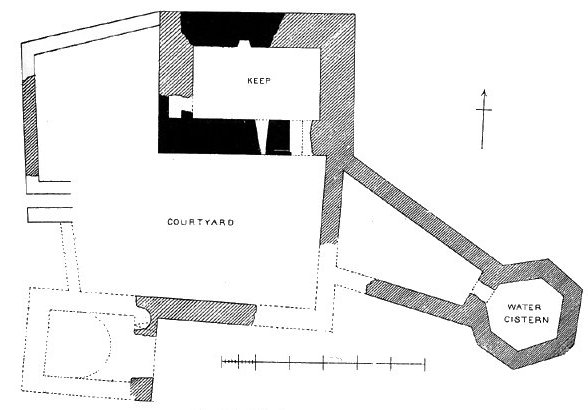
Accommodation
- Places - Outdoor Activities -
Travel
- Castles
Produced by Daniel Mackenzie-Winters
Eilean Donan Castle
Online tour - history - photos - travel info


This is the 'Ellandonan Castle' (sic) entry in
The Castellated and Domestic Architecture of Scotland (1887-1892)
by David MacGibbon and Thomas Ross
who travelled around compiling
drawings and descriptions of nearly every castle, tower house and mansion in the country.
This beautifully situated ruin occupies the summit of a small rocky island at the junction of three lochs, being at the eastern extremity of Loch Alsh, where it branches into Loch Duich and Loch Long.
The situation is naturally strong and commanding, and was likely to be selected at an early period for a fortress. It is supposed to have been originally occupied by a vitrified fort, which was replaced in the 13th century by a castle consisting of a great wall of enceinte. Colin Fitzgerald, son of the Earl of Desmond, was appointed its constable after the battle of Largs. In the 14th century it was in the hands of Randolph, Earl of Moray, who, in 1331, adorned its walls with the heads of 50 victims, as a warning to the inhabitants of the district. During the 15th and 16th centuries Ellandonan was a chief strength of the Mackenzies of Kintail, and many stories are told regarding it.
In 1504 there was a great insurrection in the Highlands, which it took the king's forces two years to quell. The castle was then taken by Huntly. In 1539 it was attacked by Donald Gorm of Lewis, a great foe of the clan Kenzie, and although feebly garrisoned, the assailants withdrew in consequence of the death of their leader, who was shot by an arrow from the castle. In 1719, after the defeat of the insurrection of 1715, the castle was held by a body of Spaniards under Wm. Mackenzie, Earl of Seaforth, when it was battered and ruined by three English men-of-war.
The situation of the castle is very fine but unfortunately its architectural features are almost entirely destroyed. The outline of the enceinte, which has been of a quadrilateral form can however still be traced, and some portions of the enclosing wall are yet standing. At the west side a narrow passage between two walls seems to have formed the entrance from the lake. It then, doubtless, contained a steep staircase leading from the landing-place to the courtyard above, but it is now only a slope of loose stones.
The keep occupied the north-east angle of the enclosure. Like the keeps of several of the other Western castles it was probably erected in the 14th century; its north and east walls seem to have been raised upon the older wall of enceinte. It was a rectangular structure 57 feet long by 43 feet wide, with walls about 10 feet in thickness. The foundations exist all round, and fragments of the north and south walls are standing of considerable height, but almost entirely devoid of architectural features. The entrance door was at the south-east angle - one jamb, with the bar-hole, being still preserved. The staircase was probably carried up in the adjoining angle of the wall, but of this there is now no trace. A narrow loop occurs in the south wall, not far from the doorway, and the remains of a wall-chamber are traceable in the west wall.

A remarkable structure still survives on the east side of the castle. This consists of a heptagonal tower 20 feet in diameter internally, placed at a considerably lower level than the courtyard of the castle. This enclosure, which was always open to the sky, seems to have been a water tank. It still contains water, but it is of a very stagnant and unwholesome appearance. There is possibly a spring in it, as in the similar rock on which stands Kismull in Barra, and the tower has been erected to secure it for the use of the garrison. The castle is connected with the water tower by means of a long sloping passage in court, with walls of considerable size and strength, being about 5 feet in thickness, and probably when complete about 15 feet in height.
Taken from
The Castellated and Domestic Architecture of Scotland (1887-1892)
Volume 3, page 82 onwards
by David MacGibbon and Thomas Ross
You can now view 4 of the 5 volumes online courtesy of archive.org
Click here to view the section on Eilean Donan
More info is available on my:
Main Eilean Donan Page - Eilean Donan Detailed History
My photos of the Castle:
external views --
courtyard scenes -- the bridge
Link to the Official web site for Eilean Donan Castle
This web guide is produced by Daniel Mackenzie-Winters
Email: contact@scotland-info.co.uk
The Internet Guide to Scotland
Copyright Daniel Mackenzie-Winters
https://www.scotland-inverness.co.uk/Chatelaine/EDC/edc-mgr.htm



